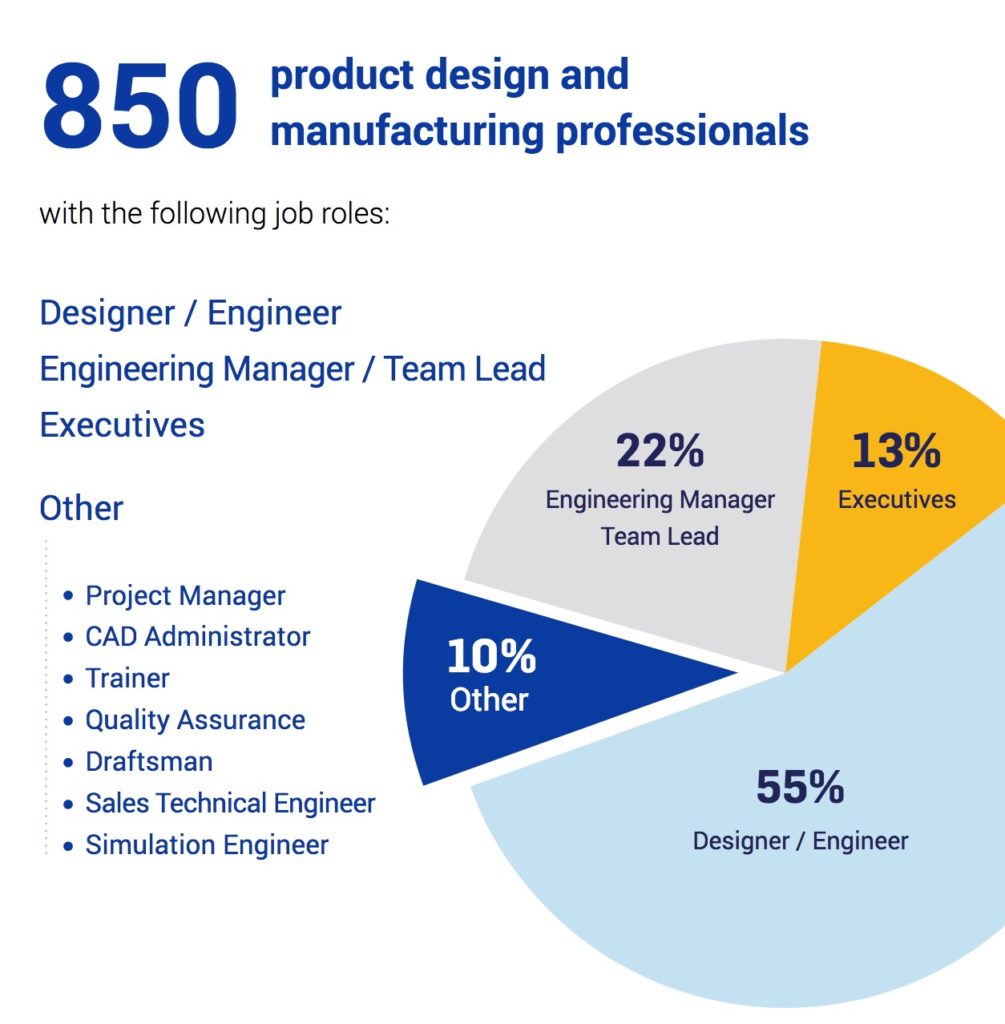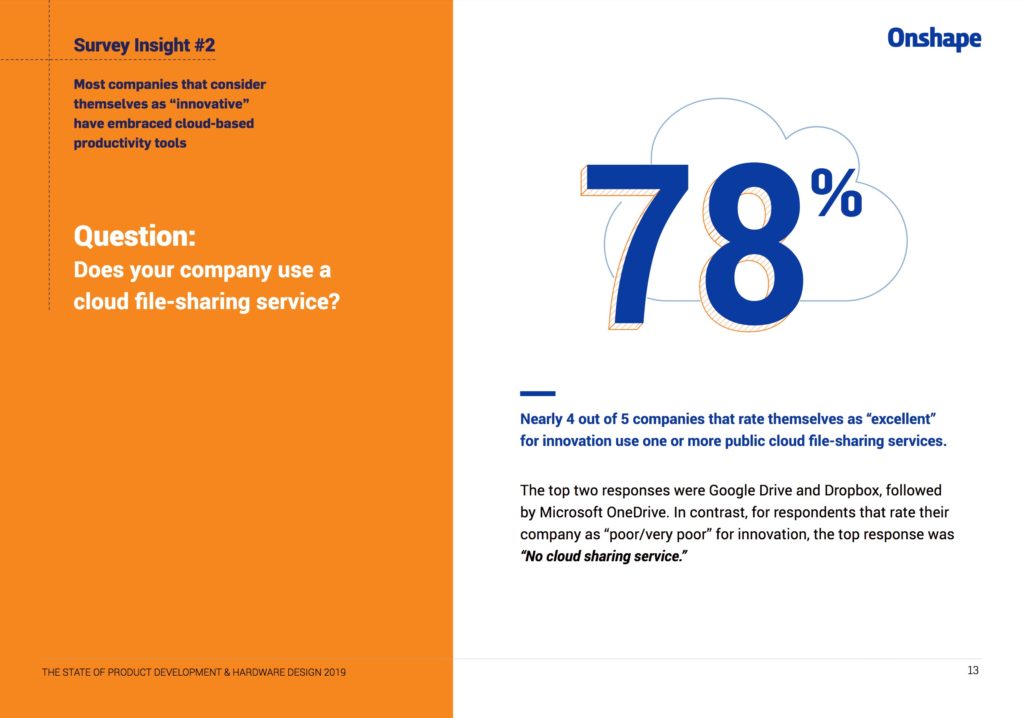
Onshape announced available of their first ever study about product design and development. The study is available online for free. You just need to give Onsahpe your email, phone and other contact information, which I did. Navigate to the following link to get it.
Here is a stat about the research – 850 people with at least 50% of them engineers and designers.

My PLM twisted mind caught the main conclusion – process improvement is more important for engineers and companies overall than design tool improvements. Onshape report states top 3 things that must be improved – (1) communication, (2) version control; (3) visibility.
Communication – 89% say they want earlier and better communication between members of their extended design team. This could be addressing miscommunication or not enough communication between internal teams or with external partners – or even missed opportunities to get design feedback from contributors who could have game-changing ideas.
Version Control – 86% say they need to reduce errors resulting from working on the wrong version of a design or receiving important information too late. These are preventable data management issues that result in costly manufacturing mistakes, and ultimately, a slower time to market.
Visibility – managers and executives at these same companies, the top priority for improvement is visibility. 89% of those respondents say they want the ability to monitor their product design team’s progress anytime without having meetings, sending emails, or making phone calls.
I captured few interesting data points. One – vast majority of the companies are using cloud storage to store or manage files.

I can confirm these numbers – I can see the same from almost every single customer of OpenBOM (Disclosure – I’m CEO and co-founder). Usually, when OpenBOM generates a bill of materials, we learn that files are located in one of the cloud file storages – Dropbox, Google Drive, or Microsoft OneDrive.
Another interesting data point – companies think PDM/PLM can improve processes, they consider it as the necessary evil and think it must be a better way.

So far so good, you can say? Cloud tools will save the world, will provide better visibility, transparency, and communication. Where is the catch? Onshape survey gives you two data points – (1) design tools are good enough; (2) process must be improved. I can see a conflict here.
If you read earlier Onshape stories you will learn that CAD files are the main reason for design gridlock in communication. Check here. Here is the passage:
Root Cause of Design Gridlock: Files. One of the key insights we had when we started Onshape was that the root cause of design gridlock is files. Storing design data in files is an old, obsolete idea. Files are often hard to find and search for because they are stored across many places. Files are hard to control because they can be copied, and every copy is a source of new copies. Files are hard to keep synchronized between many locations, creating confusion about versions. Files that reference each other are inherently brittle because file paths are always changing (I’m looking at you, old CAD assemblies).
And continue here – file based CAD systems are actually the root cause of the problem.
With file-based CAD, if you are making an assembly with two parts, that’s three files. And they all live on your hard drive. You might have iPhone-Stand-Assembly and iPhone-Stand-Base and iPhone-Stand-Holder. If you want to change the name of one of the part files, you can’t just do it. If you do, the assembly is not going to know what’s happening. Traditional CAD relies on file names to establish critical relationships between parts and assemblies.
So, here is a paradox. Engineers are, in general, satisfied with design tools and at the same time, CAD file systems are preventing them from improving communication, version control, and visibility. One possible answer is to leave file-based CAD systems behind and adopt new cloud-based CAD design tools (eg. Onshape is one of the best examples, but there are others as well). An alternative option is to use hybrid based systems with existing CAD systems and connected cloud-based tools to improve data management, design collaboration, communication and version control using cloud-based tools (examples here can vary from cloud-based tools like OpenBOM, hybrid cloud CAD systems such as Autodesk Fusion360 cloud PDM/PLM connected to file-based tools (eg. 3DEXPERIENCE.works or Solid Edge Collaboration portal).
Why designers and engineers are saying they are happy with the tools and at the same time the same tools potentially preventing them from achieving the desired level of communication, transparency and version control. This is a good question that reminded me of the famous liar’s paradox. While acknowledging the problem, engineers don’t really want to move to new tools. Also, PDM/PLM tools are usually the responsibility of IT and not something engineers like to be involved in.
What is my conclusion? Everyone needs data. These days we do care even more about the data. But nobody wants to be responsible for data management. I learned it for the last two decades developing and selling different PDM, PLM and other collaboration and communication tools for engineers. Engineers and manufacturing companies are experiencing difficulties to communicate and at the same not ready to give up their existing file-based CAD tools. Where is the right solution? The jury is out. Just my thoughts…
Best, Oleg
Disclaimer: I’m co-founder and CEO of OpenBOM developing cloud-based bill of materials and inventory management tool for manufacturing companies, hardware startups, and supply chain. My opinion can be unintentionally biased.
The post CAD and PDM Improvements – Liar’s Paradox? appeared first on Beyond PLM (Product Lifecycle Management) Blog.



Be the first to post a comment.